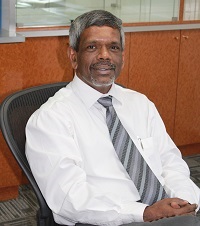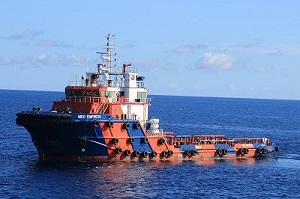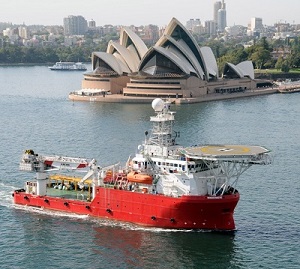The Asian OSV Market's Safe Haven
Analysts are talking of an industry-wide shake-out in the oil and gas sector.
Credit Suisse analyst Gerald Wong expects total 2015 capital spending for oil and gas companies in the Asia-Pacific region to fall 14 percent from 2014. Companies servicing firms operating in deep water are likely to be hit hard as their exploration campaigns have higher breakeven rates, but for some in Asia there is a safe haven. The region’s shallow-water oil production should be fairly well insulated even though oil majors are pulling back on exploration spending.
 It is a sentiment shared by Venkatraman Sheshashayee (“Shesh”), Deputy CEO of Miclyn Express Offshore (MEO), a leading provider of offshore support vessels (OSVs) headquartered in Singapore. “We are fortunate that the lion’s share of MEO’s assets operate in the shallow water production phase of the upstream oil and gas cycle, which is less exposed to oil price volatility when compared to the exploration and development phases,” says Shesh.
It is a sentiment shared by Venkatraman Sheshashayee (“Shesh”), Deputy CEO of Miclyn Express Offshore (MEO), a leading provider of offshore support vessels (OSVs) headquartered in Singapore. “We are fortunate that the lion’s share of MEO’s assets operate in the shallow water production phase of the upstream oil and gas cycle, which is less exposed to oil price volatility when compared to the exploration and development phases,” says Shesh.
The offshore support market in Australia is in flux, says Shesh, moving from a period of high activity in development to a period of sustained support in production. The market in Asia continues to focus on production, with increased activity in inspection, maintenance and repair (IMR) and life-of-field services.
A Challenging Year
“2015 is going to be challenging,” he adds. “On the demand side, the slide in the price of oil is likely to slow down exploration and production investment, which will affect both utilization and rates. On the supply side, the orderbook is still substantial, which is likely to exacerbate the problem. Having said this, companies with strong charter backlogs, robust client relationships and dependable balance sheets will continue to thrive.”
 Given the trend of oil prices, Australasia can expect to see budget cuts by oil companies. It is likely that many newbuild projects will be cancelled or delayed. Banks will be more cautious when approached for financing. This calls for courage and resilience in no small measure, says Shesh. “MEO’s strategy is and will be to focus on long-term charters for our vessels. This allows us utilization security, revenue visibility and some extent of risk mitigation. MEO’s fleet has been growing steadily on the back of long-term charters and will continue to do so.”
Given the trend of oil prices, Australasia can expect to see budget cuts by oil companies. It is likely that many newbuild projects will be cancelled or delayed. Banks will be more cautious when approached for financing. This calls for courage and resilience in no small measure, says Shesh. “MEO’s strategy is and will be to focus on long-term charters for our vessels. This allows us utilization security, revenue visibility and some extent of risk mitigation. MEO’s fleet has been growing steadily on the back of long-term charters and will continue to do so.”
MEO has commenced a program of internal consolidation, focusing on operational efficiency and employee development. “We believe that this is the right time to focus on these areas, reinforcing our people and our processes, both of which will make us more robust and give MEO a competitive advantage for the years to come.”
Currently MEO’s vessels are deployed about 60 percent in Asia with the rest in Australia and the Middle East. Shesh hopes to enter new regions gradually and in a staged manner. “As we do so, the deployment proportion of our fleet will change. We expect to see this happening over the next three-to-five years.”
Windermere & the Subsea Market
Last year, MEO acquired the Windermere, a DP-2 subsea operations vessel. Windermere is on a five-year charter to a subsea services provider in South East Asia.
 The vessel is designed for wellhead servicing, inspection and construction diving, and ROV support. Windermere boasts its own moon pool, a 15-man saturation diving system plus an air diving system. It also has an active, heave-compensated, 50-metric-ton knuckle-boom subsea crane to provide true operating capability down to 1,500 meters in water depth. The vessel accommodates up to 120 personnel with onboard facilities including a 700-square-meter deck and an elevated helipad at the bow.
The vessel is designed for wellhead servicing, inspection and construction diving, and ROV support. Windermere boasts its own moon pool, a 15-man saturation diving system plus an air diving system. It also has an active, heave-compensated, 50-metric-ton knuckle-boom subsea crane to provide true operating capability down to 1,500 meters in water depth. The vessel accommodates up to 120 personnel with onboard facilities including a 700-square-meter deck and an elevated helipad at the bow.
For MEO, the vessel is a game changer, a key investment in the subsea market.
It’s a market that Douglas-Westwood (DW) expect $122 billion to be spent on globally over the next five years – an increase of 64 percent compared to the previous five-year period. The IMR (inspection, maintenance and repair) of existing infrastructure is expected to account for 42 percent of total vessel operational day requirements, the largest of all market segments.
Unlike field development, the IMR market is less associated with deepwater/subsea and is driven by conventional, shallow water infrastructure, says Chen Wei, a researcher in the DW Singapore Office, echoing the safe haven sentiment.
Asia and North America will dominate global IMR requirements, he says, accounting for 46 percent of projected expenditure with Asia in particular becoming an increasingly attractive market to international contractors as local operators turn to more modern dive-support vessels to improve operational efficiency.
The safe haven is expected to continue as long as the majority of subsea developments in Asia are located in shallow waters, but the market is expected to move steadily toward water depths beyond 1,000m over the next five years. Deepwater developments are driven by projects such as Chevron’s Gandang, Gehem and Gendalo fields, Reliance Industries M-1 and Shell’s Kamunsu East. Both Malaysia and India are expected to account for the largest field development-related vessel demand in Asia over 2015-2019, says Chen.
– MarEx
